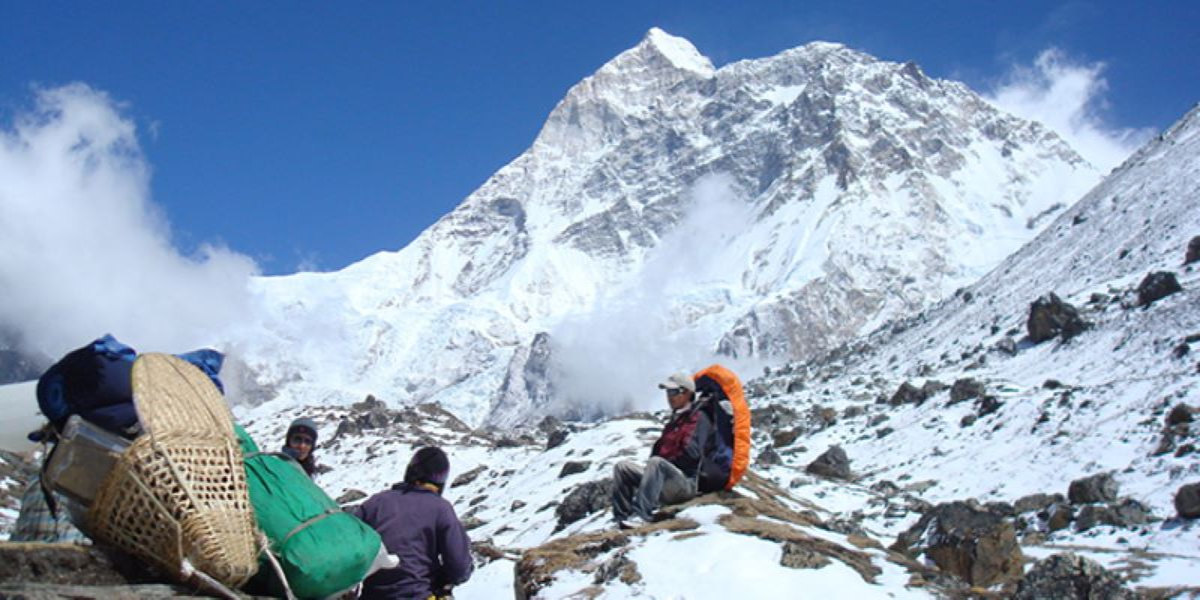
Kanchenjunga Base Camp Trek
Tour Gallery
Overview
Kanchenjunga Base Camp Trek
Kanchenjunga Base Camp Trek is a challenging and rewarding trek in the eastern region of Nepal. Kanchenjunga, the third-highest mountain in the world, is located on the border of Nepal and Sikkim, India.
The trek takes you through remote and beautiful landscapes, passing through lush subtropical forests, traditional villages, and high alpine meadows.
- Get to the foot of the world’s third-highest peak, Kanchenjunga height (8,586m).
- Mirgin-La Pass (4,663m), Tamo La Pass (3,900m), Dubai Pass, and many more unnamed passes.
- Explore Nepali and Tibetan culture.
- Explore the natural landscapes, wildlife, forests, rivers, and lakes.
- Cross several glaciers like Yalung Glacier and Kanchenjunga Glacier.
Kanchenjunga Base Camp Trek is an amazing trek to the foot of Kanchenjunga height (8,586 m). You will explore the journey to the third-highest peak in the world with a wonderful trekking crew.
The trail also includes traversing a pathway to Kanchenjunga trek massif and glacier torrents. There also comes passes, rivers, forests, valleys, viewpoints, waterfalls, and many more natural gifts along the way.
We offer a 26-day package, providing you with professional guidance and accommodation facilities. Here, we have prepared detailed information about the trek to Kanchenjunga Base Camp.
Firstly, Kanchenjunga Base Camp Trekking starts and ends with Kathmandu City. We will travel to the east of Nepal and explore the region to reach our destination. Our first stop will be Biratnagar, from where we will head north toward Kanchenjunga Base Camp Trek.
Secondly, Our trekking journey begins once we arrive in Suketar. The trail of our entire journey is followed by ridges, rivers, landscapes, lakes, forests, and acclimatization at certain elevations.
We will also cross high passes like Mirgin-La Pass (4,663m), Tamo-La Pass (3,900m), Dubai Pass, and many more unnamed passes.
More About Kanchenjunga Base Camp Trek
The trek typically takes around 20-25 days to complete, and requires a good level of physical fitness and acclimatization.
It is also important to note that the trek is considered to be a remote and strenuous trek and it is important to have a good travel insurance, adequate equipment and to be prepared for the altitude and weather changes.
Overall, you will enjoy the scenic trekking experience and get a chance to visit one of the world’s highest peaks. Moreover, you will be under the guidance of professionals in trekking and tourism, so your adventure will be secure and full of exciting events.
Trip Highlights
The trek typically takes around 20-25 days to complete, and requires a good level of physical fitness and acclimatization.
It is also important to note that the trek is considered to be a remote and strenuous trek and it is important to have a good travel insurance, adequate equipment and to be prepared for the altitude and weather changes.
Overall, you will enjoy the scenic trekking experience and get a chance to visit one of the world’s highest peaks. Moreover, you will be under the guidance of professionals in trekking and tourism, so your adventure will be secure and full of exciting events.
What's Included
Included Services
- ✓Accommodation in mountain teahouses
- ✓Kathmandu Bhadrapur Kathmandu flight
- ✓Kanchenjunga conservation area permit
- ✓Restricted area permit
- ✓All Ground Transportation
Excluded Services
- ✗Visa Charges
- ✗International Airfare
- ✗Personal Expenses such as shopping, bar bills, hot shower, telephone, laundry, titbits etc
- ✗Your travel and medical insurance
Detailed Itinerary
More Information
How Difficult Is Kanchenjunga Base Camp Trek?
The Kanchenjunga Base Camp trek is a challenging and strenuous trek known for its remote and rugged terrain. It involves high altitudes, steep ascents and descents, and unpredictable weather. Trekkers should be physically fit, mentally prepared, and have prior trekking experience to undertake this demanding adventure in the Himalayas.
How Long Is The Trek To Kanchenjunga Base Camp?
The duration of the Kanchenjunga Base Camp trek varies depending on the specific route taken and the starting point. On average, the tour takes around 20 to 25 days to complete. Trekkers should factor in acclimatization days, challenging terrain, and potential weather-related delays during this Himalayan adventure.
How Much Does It Cost To Trek Kanchenjunga Base Camp Nepal?
The cost of trekking to Kanchenjunga Base Camp in Nepal can vary widely depending on factors such as the trekking agency, the specific route chosen, the duration of the trek, and the services included. The average kanchenjunga base camp trek cost ranges from $2,000 to $5,000 per person, covering permits, guides, accommodation, meals, and other logistical expenses.
Is Trekking Allowed In Kanchenjunga?
Yes, trekking is allowed in the Kanchenjunga region of Nepal. However, a special permit is required to trek in the Kanchenjunga Conservation Area. Trekkers are advised to go through authorized trekking agencies and obtain the necessary permits from the Nepal Tourism Board to ensure the region’s compliance with regulations and environmental conservation efforts.
How Much Is The Permit For Kanchenjunga Trek?
The permit fees for the Kanchenjunga trek in Nepal can vary based on the seasons and the specific areas you plan to visit. Generally, the permit cost is around USD 20 per person per week for the Kanchenjunga Conservation Area Permit (KCAP) and an additional USD 10 per person per week for the Restricted Area Permit (RAP).
Is Kanchenjunga Harder Than Everest?
While both Kanchenjunga and Everest are challenging and demanding in their ways, comparing their difficulty can be subjective. Kanchenjunga is known for its remote and less-visited trails, rugged terrain, and unpredictable weather, making it a physically and mentally demanding trek. On the other hand, Everest is famous for its extreme altitude, particularly during the ascent to the summit.
What Is The Best Time To Visit Kanchenjunga?
The best time to visit Kanchenjunga is during the pre-monsoon (spring) and post-monsoon (autumn) seasons, from late March to early June and September to November. During these periods, the weather is relatively stable, offering clear skies and favorable trekking conditions to explore the stunning landscapes of the Kanchenjunga region.
What Is The Height Of Kanchenjunga?
Kanchenjunga Height: The height of Kanchenjunga, the third-highest mountain in the world, is 8,586 meters (28,169 feet) above sea level. It is located on the Nepal-India border in the Himalayas.
Where Is Kanchenjunga Located?
Kanchenjunga is located on the border between Nepal and the Indian state of Sikkim. It is part of the Himalayan mountain range, and the mountain itself spans both countries. The precise coordinates are approximately 27.7025° N latitude and 88.1475° E longitude.
About Kanchenjunga View Point?
Kanchenjunga View Point refers to various locations from which one can witness panoramic views of Mount Kanchenjunga, the third-highest mountain in the world. Popular viewpoints include Tiger Hill in Darjeeling, India, and the Goechala Pass in Sikkim, India. These vantage points offer breathtaking vistas of the majestic Kanchenjunga mountain range.
Information About Kanchenjunga National Park
Kanchenjunga National Park is a protected area in the Himalayas, spanning both Nepal and the Indian state of Sikkim. It is named after Mount Kanchenjunga, the third-highest peak globally. The park is renowned for its rich biodiversity, diverse flora and fauna, and stunning landscapes, making it a UNESCO World Heritage Site.



